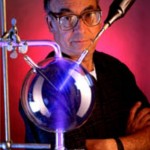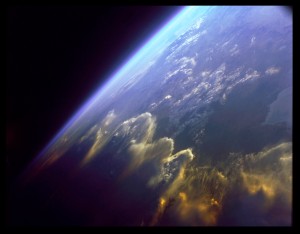Oxygen is one of life’s most essential atomic elements. As molecular biologist Michael Denton highlights in his book “Nature’s Destiny: How the Laws of Biology Reveal Purpose in the Universe,” oxygen is the key element for “one of the most important chemical reactions on Earth.”
While oxygen is the third most abundant chemical element in the universe, after hydrogen and helium, oxygen is the most abundant chemical element by mass in the Earth’s biosphere, air, sea, and land, adding one more agonizing Achilles Heel to the theory of evolution.
Origin of Oxygen Theory
Evolution’s Achilles Heel originated during the twentieth century. In 1952, Nobel prize-winning chemist Harold Urey published the book entitled “The Planets: Their Origin and Development,” which speculated that the early Earth’s atmosphere was probably like interstellar gases composed of ammonia, methane, and hydrogen—a reducing atmosphere that contains no oxygen.
In a subsequent experiment to test the theory using a reducing atmosphere, Urey’s graduate student, Stanley Miller ( pictured right), demonstrated in a laboratory model that simple organic building blocks, amino acids, can Originate through self-assembly – an evolutionist’s dream. The now infamous experiment has since been known as the Miller-Urey experiment —the cornerstone theory of the evolution industry for the origin of life.
Originate through self-assembly – an evolutionist’s dream. The now infamous experiment has since been known as the Miller-Urey experiment —the cornerstone theory of the evolution industry for the origin of life.
According to the theory, oxygen eventually was produced in the Earth’s atmosphere during what has been called the Great Oxygenation Event (GOE). Massive quantities of free oxygen were proposed to have been released into the atmosphere due to the photosynthetic activity of the bacteria known as Cyanobacteria, the only known oxygen-producing microbe.
Theory Cracks
Until last month, a mechanism for oxygenating Earth’s oceans was unknown aside from the traditional view that oxygenation of the atmosphere was a prerequisite to the oxygenation of the ocean. Geologist Timothy Lenton of the University of Exeter, UK, published a research paper in Nature Geoscience, as the leading investigator proposes that the evolution of new, more complex multicellular life forms (eukaryotes) “oxygenated much of the deep oceans.”
“There had been enough oxygen in ocean surface waters…, but the dark depths of the ocean remained devoid of oxygen,” Lenton noted in an interview published in ScienceDaily. “We argue,” Lenton continued, “that the evolution of the first animals could have played a key role in the widespread oxygenation of the deep oceans. This, in turn, may have facilitated the evolution of more complex, mobile animals.” Notice the use of the terms “could have” and “may have.”
In a very candid ScienceDaily interview with the study’s co-author, Simon Poulton of the University of Leeds, UK, notes that ″This study … [actually] questions whether the long-standing belief that there was a major rise in atmospheric oxygen at this time is correct… Geochemists need to come up with new ways to decipher oxygen levels on the early Earth.″
Actually, geochemists have long been divided over Harold Urey’s cosmochemistry theory. Just a year after Urey published his interstellar gas theory, University of Chicago nuclear geochemist Harrison Brown observed that reducing gases in the early Earth’s atmosphere were at least a million times lower than interstellar gases. Therefore, Brown concluded either the Earth lost its original interstellar atmosphere or never had Urey’s reducing atmosphere.
In the 1960s, Princeton University geochemist Heinrich Holland and Carnegie Institution geophysicist Philip Abelson agreed with Brown’s conclusions. Abelson, the editor of the journal Science and editor of articles published by the American Association for the Advancement of Science, explained in 1966 –
“What is the evidence for a primitive methane-ammonia atmosphere on Earth? The answer is that there is no evidence for it, but much against it.”
Later in the 1970s, Canadian geologists Erich Dimroth and Michael Kimberly issued the following finding: “In general, we find no evidence in the sedimentary distributions of carbon, sulfur, uranium, or iron that an oxygen-free atmosphere has existed at any time during the span of geological history recorded in well-preserved sedimentary rocks.”
Belgium Biochemist, Marcel Florkin, joined Dimroth and Kimberly in 1975, noting that “the concept of a reducing primitive atmosphere has been abandoned,” and the Miller–Urey experiment is “not now considered geologically adequate.”
Even molecular biologists Sidney Fox and Klaus Dose joined the discussion in 1977, declaring, “The inference that Miller’s synthesis does not have a geological relevance has become increasingly widespread.”
By 1995, Jon Cohen, senior editor for the journal Science, the flagship journal of the American Association for the Advancement of Science (AAAS), announced –
“The early atmosphere looked nothing like the Miller–Urey simulation.”
 With the evidence becoming too massive to ignore any longer, in 1998 Richard Monastersky, writing for National Geographic, concluded –
With the evidence becoming too massive to ignore any longer, in 1998 Richard Monastersky, writing for National Geographic, concluded –
“Many scientists now suspect that the early atmosphere was very different from what Miller first supposed.”
In the words of legionary scientist James Lovelock, at oxygen concentrations “above 25% very little of our present land vegetation could survive the raging conflagrations [fire storms] which would destroy tropical rain forests and arctic tundra alike… The present oxygen level [concentration] is at a point where risk and benefit are nicely balanced.” The concentration of oxygen in Earth’s atmosphere is 21%.
“All respiring organisms are caught in a cruel trap,” American biochemist Irwin Fridovick explains: “The very oxygen which supports their lives is toxic to them and they survive precariously.”
Philosophy-Driven
Urey’s cosmochemistry theory to explain the origin of life, while once popular, has emerged as yet one more Achilles Heel for the philosophy-driven evolution industry.
“It is not that life adapted to oxygen or to the atmospheric conditions on Earth,” Denton concludes, “but that long ago, long before the first organism, long before the formation of the Earth… the general character of the atmosphere of our planet was already built into the order of the cosmos.”
Genesis
In contrast to the Genesis account written by Moses, evolution exists only as a philosophy.
Evidence from origin-of-life research to validate the theory of evolution scientifically remains speculative.
Oxygen, Evolution’s Achilles Heel is an Origin of Life article.
Darwin Then and Now is an educational resource on the intersection of evolution and science, highlighting the ongoing challenges to the theory of evolution.
Move On
Explore how to understand twenty-first-century concepts of evolution further using the following links –
-
- The Understanding Evolution category showcases how varying historical study approaches to evolution have led to varying conclusions. Subcategories include –
- Studying Evolution explains how key evolution terms and concepts have changed since the 1958 publication of The Origin of Species.
- What is Science explains Charles Darwin’s approach to science and how modern science approaches can be applied to different investigative purposes.
- Evolution and Science feature study articles on how scientific evidence influences the current understanding of evolution.
- Theory and Consensus feature articles on the historical timelines of the theory and Natural Selection.
- The Biography of Charles Darwin category showcases relevant aspects of his life.
- The Glossary defines terms used in studying the theory of biological evolution.
- The Understanding Evolution category showcases how varying historical study approaches to evolution have led to varying conclusions. Subcategories include –



